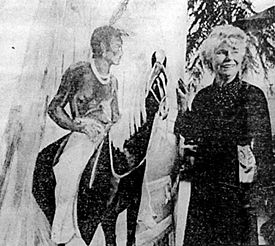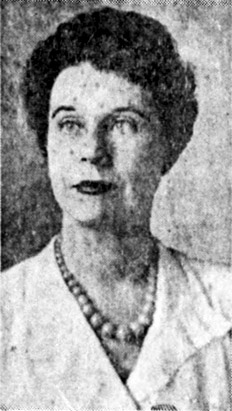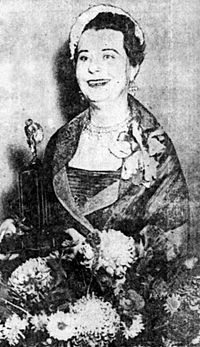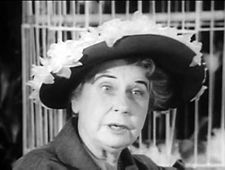Eleanor Bridges
Eleanor Massey Bridges (born December 16, 1899 in Columbus, Georgia; died June 5, 1987 in Birmingham) was a civic activist and artist.
Early life
Bridges was born to Richard and Bessie Spencer Massey. Her father was the founder of the Massey Business College. The family moved to Birmingham when she was a few months old, and she grew up, with eight siblings, in the Richard Massey residence on Red Mountain, famed for its Italian gardens which were the setting for numerous parties and dances. Because she preferred only silver and blue in her bedroom, her father agreed to have the room's chandelier sent off for silver-plating. Eleanor befriended her neighbors, Mildred Kettig and Mary Hard, and chatted up President Taft when he was a guest at the house during his 1909 tour. The house was later demolished for the Elton B. Stephens Expressway.
Eleanor decided as a child to pursue a career as an artist. She attended the Margaret Allen School and took lessons from local artists such as Hannah Elliott, though her father had disapproved. She continued at the Ogontz School for Young Ladies in Abington, Pennsylvania, where, for a year, she was the roommate of Amelia Earhart. On a whim, she joined a suffragists' parade in Philadelphia, missing an appointment with her school chaperone. The incident nearly led to her expulsion, but she was able to continue at the Pennsylvania Academy and studies sociology at the University of Pennsylvania. During the summer she operated a tractor and filled in as a cook at a local farm, until the lady of the house heard that she was an Ogontz girl and threw a party in her honor. She continued her studies throughout her life, at prestigious institutions such as Harvard, the Sorbonne and the Académie Julian. In Birmingham she took classes at Birmingham-Southern College and Samford University.
At the age of 19 she met World War I veteran and aspiring sculptor Georges Bridges at a debutante party in Birmingham. They were engaged within a week, despite the strong objections of her father. They were married at her family house in front of friends while the family remained upstairs, then honeymooned at a camp on the Warrior River. They studied together at the Cincinnati Academy of Fine Arts until their first daughter, Mary Eleanor, called "London", was born. In 1921 they built a large pink stucco house on Edgewood Boulevard where Georges devoted himself to sculpting, soon winning prizes and commissions. They stabled horses to ride through Shades Valley and around Edgewood Lake and summered at Lake George.
Expatriates
Soon the couple moved to Paris and circulated in the expatriate community there, which included Tallulah Bankhead, Norman Bel Geddes, Bud Fisher, Ernest Hemingway, and F. Scott and Zelda Fitzgerald. Because of Georges' strong resemblance to the actor Douglas Fairbanks, the two often played pranks on others. They later lived in Greece, Turkey, Morocco and Mallorca, where she founded an art colony. There she met the Duchess of Malta who arranged an exhibition of her paintings in Madrid.
Return to Birmingham
In 1928 the Bridgeses returned to Birmingham on a freighter, via Cuba. They had not intended to stay, but, when the Great Depression came, they took in several children who had been abandoned at mining towns in the district. Over the next decade as many as eighteen children lived with them in dormitories added on to the house.
Bridges styled the undertaking as a boarding school and developed her own curriculum, focusing on art and literature. Her theories on education attracted attention and she often made presentations to share her experiences. A county delinquency officer visited one day to insist that the children be enrolled in public schools. Incensed, Bridges packed them all up to move to Taxco, Mexico, where she ran a winter art colony. The subsequent winter found them in California. No formal adoption papers were filed and most of the children returned to their families when the economy recovered. Later they used the same rooms to house recovering alcoholics under a local doctor's care.
The Bridges' parlor was a landmark in the progressive social and cultural scene. They hosted themed discussions each Sunday evening. The Little Theatre had its beginnings in those salons. Years later they launched the Valley Civic Theatre with a performance of Oscar Wilde's "Salome" in the front yard. The gardens surrounding the house on the 2-acre estate were filled with large trees, flowers and fountains. When Carmen Miranda made platform shoes famous, Eleanor began buying them. To Georges' eye they gave her petite 5'-3" frame "a better line", so she turned to having them custom made when they later fell out of fashion.
Civic work
Bridges gave up her studio there to spend more time in Birmingham in the 1950s, joining several civic boards. She was an officer of the Birmingham Beautification Board, the Women's Civic Club of Birmingham, the Birmingham Festival of Arts, and the Birmingham Art Association. Among her achievements were establishing the Festival of Arts as a major cultural event. She also helped launch the Artist's Guild, the Birmingham Civic Opera and the Women's Committee of 100. She headed the women's division of the Community Chest in 1939 and organized innumerable fund-raisers for everything from a Birmingham performance by the New York Metropolitan Opera to developmental projects in China.
She and her husband provided free art classes to students from Homewood City Schools and Parker High School. She taught programs at Vasser College and was on the board of the Women's Medical College of Pennsylvania and spoke annually on the importance of cultural education at Miles College. She was inducted into the Birmingham Post-Herald's "Roll of Honor" in 1938 and named Birmingham Woman of the Year in 1953. She was also vice president for art and culture for the Birmingham Centennial committee.
As a spokeswoman for Birmingham's cultural life, Bridges was interviewed (at The Club) by Howard K. Smith for the 1961 CBS documentary "Who Speaks for Birmingham?". Her ignorance of injustices was contrasted with testimony from leaders in the African American community and highlighted the sharp distinctions in perceptions of life under segregation.
Bridges had intended for her period of civic work to be short-lived, but found the effort engrossing and unending. Her grand scheme was a "100-year plan to make Birmingham the cultural center of the South". When Georges fell ill in 1975, she resigned many of her positions to care for him. He died in February 1976.
Artwork
Throughout her life, Bridges was a prolific painter, most known for her portraits, which hang in private collections around the world. She painted the official portraits for Governor Lurleen Wallace and Senator James Allen.

A favorite genre was portraits of dogs, including commissions to paint Presidential pets "Fala" (Franklin Roosevelt's scottie) and "Liberty" (Gerald Ford's golden retriever). One hundred of her canine portraits were exhibited at the Birmingham Museum of Art. Fifty of them were re-assembled for a "Dog Daze" tour, which was exhibited around the state during the American Revolution Bicentennial. She donated a portion of her pet commissions to animal welfare charities. She also served as president of the Alabama Society for the Prevention of Cruelty to Animals.
Bridges was commissioned to paint a 18-foot x 35-foot mural depicting the construction of the Old State Bank Building in Decatur in the 1950s. She also painted the reading-room mural at the Woodlawn Public Library. In 1980 she was commissioned by Gary Smith to paint a mural for the lobby of the Brown-Marx Building. Because the lobby was paneled in pink marble, she suggested installing a constructed cylinder in the center of the room to support the mural. The resulting Cyclorama of Birmingham History was left incomplete as her health declined. It was displayed in that state at the BellSouth Building and then stored in the Lyric Theater until the opening of the Birmingham History Center, where it is now on display.
In her later work, Bridges took care to use archival-quality materials and painted strictly in oils, with an eye toward the longevity of her artwork.
Other interests
Always interested in academics, Bridges frequently took classes at area colleges. In 1977 she enrolled in the general studies program at Samford University to complete her degree. She was a frequent public lecturer and taught a UAB Special Studies course called "More Power to You", aimed at helping older women further themselves as individuals. Bridges was also a collector of bells and antique hats, an active gardner, and a member of the United Daughters of the Confederacy and the Daughters of the American Revolution.
Bridges died in 1987. She was survived by three of her siblings and her daughter, London.
References
- Elliott, Hannah (1942) "Eleanor Massey Bridges & George Bridges". Federal Writers Project.
- Walker, Alyce Billings (June 18, 1947) "Magic City's Women's Club Casts Long Shadow in Civic Results." The Birmingham News
- Hill, Miriam Gann (October 16, 1952) "Birmingham Woman of the Year for '53 is Mrs. Georges Bridges, civic leader." The Birmingham News
- Powell, Lane (c. 1976) "Fun-Raising." unknown publication, clipping from supplemental materials, Rittenhouse-1980
- Atkinson, Clettus (April 1976) "'Dog Daze' early for Eleanor Bridges" Birmingham Post-Herald
- "Bridges family played important role in budding Valley culture." (October 20, 1976) Shades Valley Sun
- "Portrait of an Artist: Eleanor Bridges" (c. 1976), unknown publication, clipping from supplemental materials, Rittenhouse-1980
- Barton, Olivia (November 20, 1978) "Age only improves people like me." The Birmingham News
- Rittenhouse, Berdine L. (January 21, 1980) "A Memoir: Eleanor Massey Bridges, Feminist: Life in a Segregated Society" oral history interview. UAB.
- Bell, Elma (1982) "'Almost as old as the city,' she plans to paint its history." The Birmingham News
- "At 80, painter begins cyclorama" (January 1983) Birmingham Post-Herald
- "Service tomorrow for cyclorama artist." (June 9, 1987) Birmingham Post-Herald


